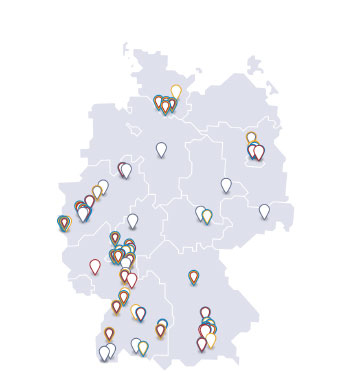READOUTsmart - REal ADherence mOnitoring in mUlTiple sclerosis applying the electronic device RebiSmartTM
Titel der Studie/Acronym
READOUTsmart - REal ADherence mOnitoring in mUlTiple sclerosis applying the electronic device RebiSmartTM
Zielsetzung/Fragestellung
Bewertung der Therapie-Adhärenz bei RMS-Patienten, die mit
Rebif® behandelt werden, mit Hilfe der automatischen
Auslesefunktion des elektronischen Injektors RebiSmartTM.
Indikation
- Multiple Sklerose
Wirkstoff
- Interferon beta 1a (deutsch)
Handelsname(n)
Rebif®
Geplante Anzahl vorgesehener Studienzentren: für die Untersuchung insgesamt
75
Geplante Patientenzahl: für die Untersuchung insgesamt
400
Patientenzahl: für die Untersuchung insgesamt
392
Kontaktperson
Zessack, Dr. Norbert
Leiter Medizin Neurologie
Merck Serono GmbH
Alsfelder Str. 17
64289 Darmstadt
Deutschland
norbert.zessack@merckserono.net
Telefon: 0049-6151-6285-519
Telefax: 0049-6151-6285-557
Unternehmen
Merck Serono GmbH
Alsfelder Str. 17
64289 Darmstadt
Deutschland
Stand der Information
11.04.2016
Status der Studie
Studie bereits abgeschlossen
Zusammenfassung der Ergebnisse
Ergebnisse (PDF)
Literaturangaben
Study title: REal ADherence mOnitoring in mUlTiple sclerosis applying
the electronic device RebiSmart
Study acronym: READOUTsmart
Study identifier EMR 200136-542
Type of study: Non-interventional study
Indication studied: Multiple sclerosis
Sponsor: Merck Serono GmbH
Alsfelder Straße 17
64289 Darmstadt
Dr. Torsten Wagner
Phase of study: IV
Adherence was assessed within this NIS in a quantitative and qualitative manner and
quantitative adherence was the primary endpoint.
Quantitative adherence was defined as the proportion of injections that were administered as defined per treatment schedule; the data for this assessment was collected by means of the RebiSMART® device. In the first 12 months, mean quantitative adherence was 89.6%, and the majority of patients had quantitative adherence between 95 and < 105% during this time. The proportion of patients with quantitative adherence between 75 and < 95% was 17.1% and 15.9% of patients had adherence levels < 75% over the first 12 months. The minimal documented quantitative adherence was 2.6% indicating that there were some few outliers with very low adherence.
In the further course of the study (i.e. months 12 to 24), the mean quantitative adherence was slightly lower (83.3%). Nonetheless, for those patients for whom data was available for both study years (i.e. first and second year), the median ratio of quantitative adherence from the first year vs. the second year was 1.0, indicating that quantitative adherence was highly similar in at least half of the patients.
Subgroup analysis of quantitative adherence according to baseline EDSS score failed to show a major impact of disability on the primary endpoint Subgroup analyses
according to gender and age (< 37 vs. ≥ 37 years) failed to show any major effects of these factors on quantitative adherence, although at any time point of the study, women showed a slightly higher mean quantitative adherence. Similarly,
the negative impact of previous history of MS medication intake on quantitative adherence was somewhat lower than expected: patients who had taken MS medication previously showed slightly lower quantitative adherence, than therapy-naïve patients.
Adherence is likely to be negatively influenced by the experience of previous therapy
failure, and especially therapy related side effects. It should be kept in mind that
the number of patients with a history of previous treatment was very low in this NIS and that most patients had been only recently diagnosed with MS and showed low disease activity at baseline.
Cross-analysis of quantitative adherence versus self-rated adherence after 1 or 2 years failed to show a strong association between self-assessed and actual quantitative adherence. This finding might be affected by the unequal distribution of self-rated adherence and a high number of missing values.
Qualitative adherence was defined as the proportion of weeks in which the patient applied the Rebif® treatment according to a correct schedule (i.e. weeks with 3 injections performed on non-consecutive days). The mean qualitative adherence was 67.0%, indicating that on average a correct treatment schedule is followed by the patients in more than 2/3 of the time. When asked about the reasons for not performing injections as scheduled, forgetting injections was reported more often than conscious decisions to avoid injections, e.g. due to side-effects.



